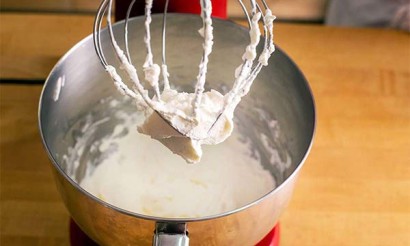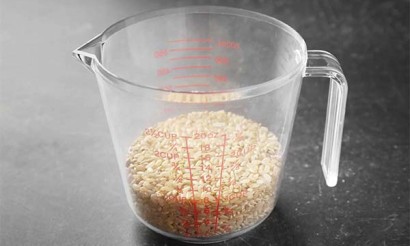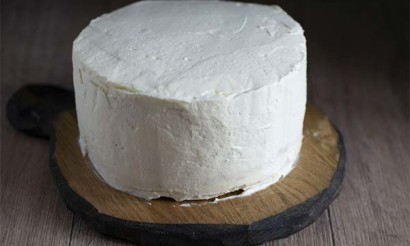How to peel fish from scales fast
Fish is a very valuable product that can be used to prepare a variety of delicious dishes in the home kitchen. But the prospect of cleaning a fish carcass for most housewives, to put it mildly, is not a very pleasant procedure. Given this factor, many supermarkets offer customers the service of cleaning and cutting right on the spot. The cost of such processing is low, and the help to housewives is huge. Of course, this option greatly facilitates the process of cooking fish delicacies. But what to do with fresh produce, which often comes into the house directly from the nearest body of water? It turns out that at home you can also clean fish quickly and accurately, if you learn a few simple rules.
What you need to clean and trim your fish
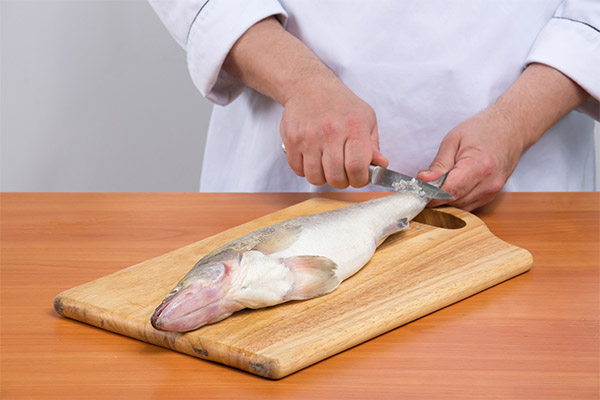
The most unpleasant thing about cleaning fish products is the scales. When processing the carcass, it flies around the kitchen, gets on clothes, dishes, the table, children and even pets. Therefore, it is not uncommon for housewives to have to do a general cleaning of the entire apartment after cooking a delicious fish dish. The reason for such unpleasant consequences is due to ignorance of the elementary rules of fish processing. First of all, it is necessary to take care about the availability of the necessary tools for cutting. Experienced housewives for this purpose always have at hand such useful devices:
- cutting board;
- kitchen scissors;
- A very sharp knife with a thin long blade;
- a spoon or fork;
- a special scraper for cleaning fish;
- some newspaper or parchment paper;
- boiled water;
- a pair of gloves to protect your hands from injury;
- a bowl or a small basin.
The listed arsenal of kitchen aids with the proper organization of any kind of fish processing will speed up the process, and most importantly - minimize its unpleasant consequences. If you follow all the recommendations that will be listed below, the kitchen will remain clean, and the manicure on the hands of the hostess - perfect. Even such gurus of the underwater world as carp and crucian carp with scales reminiscent of armor will not resist the skills of the home cook.
Useful information: Today you can easily buy a good fish cleaner in the store, equipped with a container for collecting scales. Especially high performance in electric models. Many devices of this class are supplemented with a special knife for opening the fish belly and a clamp for fixing the tail.
How to clean fish from slime
Despite the high culinary characteristics, fish is difficult to cut. Therefore, many housewives without experience refuse to cook fish dishes. If you proceed to action with the inhabitants of the rivers and seas in full armor, the cutting will pass quickly. The most unpleasant part of the initial processing is the removal of mucus from the carcass. Covered with mucous secretion, the fish tries to slip out of your hands, and often succeeds. In order to avoid such a mishap in the kitchen, you should do the following steps:
- Wear disposable gloves and only then start working with fish products.
- To remove the mucus from the carcass, put it in a sink or basin, and then put it in boiling water. It is important not to overdo the product in hot water, otherwise the slime will separate the scales along with the flesh of the fish.
- Remove the remains of the slimy grease with paper towels.
This is interesting: Some species, such as tench, can be cleared of slime with pre-salting. The salt neutralizes the slime, so the carcass doesn't slip in your hands.
How to remove scales from a fish
Once the mucus has been removed, you can begin to clean the carcass of scales. To perform this tricky procedure carefully, you need to choose the right tool. Many housewives prefer to use a fish peeler with additional functions, which really simplifies the process. But some home cooks use a fork, a spoon or a special grater for this purpose. You can clean the scales with an ordinary knife with a long blade. To avoid scales flying around the kitchen, you can choose one of two methods of cleaning:
- Determine the fish in a plastic bag, and then perform all the actions inside this limited space. Of course, the "bag" method requires dexterity and skill on the part of the performer.
- Cleaning fish in water is much easier than the previous method. You can immerse the carcass in a basin or sink filled with water, and then proceed to solve the main task. All the scales in this method of cleaning will remain in the water.
The traditional method of cleaning on an ordinary cutting board is more common than the others, although its use does not guarantee that the scales will not fly around.
Although these methods differ in detail, the technique of cleaning the body of the fish is the same in all three cases:
- Hold the fish firmly by the tail with one hand. At the same time, it should be in such a position that the head is located on the opposite side from the hostess.
- With the other hand, quickly remove the scales with an auxiliary tool in the direction opposite to its growth.
- After cleaning, rinse the carcass again thoroughly under running water.
- If cleaning is done by the classical method, then cover the cutting board with newspaper, so that the scales remain on the paper.
Tip! For cutting fish products it is better to use tools made of plastic or other non-porous material.
Fresh fish is always well cleaned. Therefore, fishermen often perform this procedure at the point of catch.
Basically, these are the basic rules for cleaning fish carcasses from scales. True, there are such questionable options as cleaning with an electric drill, but such alternative methods are hardly worth testing in the limited kitchen space.
Important: After cleaning and cutting, all the waste must be thrown out, and the garbage must be removed from the apartment, otherwise in a few hours the kitchen will be unbearable aroma.
How to clean perch from scales
Separately, we want to tell about the peculiarities of cleaning small scaly fish species: these are perch, tench, pikeperch, mackerel. It is known that these species of aquatic inhabitants have scales very tightly attached to the skin. Therefore, to remove it you need to put a lot of effort and time.
But professional cooks use a secret action in their practice: before removing scales they immerse the fish carcass in boiling water. After such water treatment, the scales stand up "on end" and can be easily separated from the skin even with an unarmed knife. But it is necessary to remove the scales in the same direction, i.e. from the tail to the head. First you need to clean the sides of the fish, and then the belly.
An important point: With this method of cleaning, the skin of the fish remains intact, and after frying it acquires an amazing taste.
How to cut a fish
Professional chefs are proficient in the technique of cutting fish of all varieties. But this skill can boast few housewives. Therefore, a few practical tips from experienced cooks will help in the home kitchen on their own to cut fish with minimal losses. With such valuable products as fish fillets, minced fish or steaks, a hostess with any practical experience can prepare original dishes and snacks for the whole family.
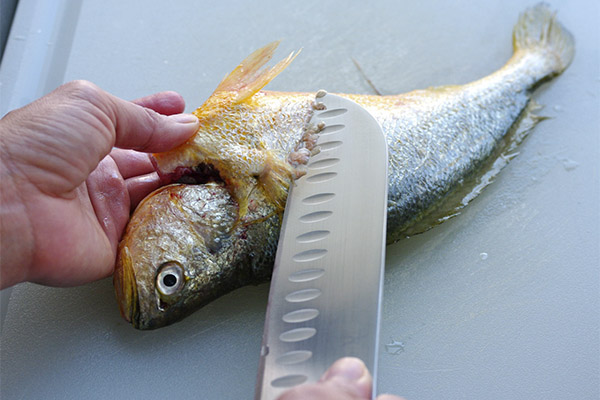
- First of all, remove all fins. If you plan to cook fish soup, you can leave the head. Then the broth will be saturated.
- Now the most responsible part of the job is the gutting. To do this, make a deep incision along the entire abdomen with a very sharp knife. When performing the operation, it is very important not to puncture the gallbladder.
- Then all the viscera should be removed from the abdominal cavity and the foil removed. If it was impossible to avoid damaging the gallbladder, quickly rinse the fish with salted water.
- Then remove gills and eyes. Rinse fish again with water.
- After draining the dressed fish carcasses, proceed to further preparation of the product, depending on the planned culinary purposes.
Fillet.
To cut the processed fish carcass into sirloin parts, you need to follow the following algorithm of actions:
- To extract the bones, place the fish on a cutting board, pressing strongly to its surface with your hand.
- If the head is not separated, make a diagonal incision under the gills.
- Make a second cut along the backbone, starting from the head. It is necessary to act with a knife, cutting through the skin and flesh of the fish to a depth of about 2.5 cm.
- Gently moving to the tail part, release the spine.
- Then go again, making even cuts in the upper part of the carcass.
- In this way, gradually release the sirloin from the top. The slower the process goes, the more small bones will be extracted from the flesh.
- Separating the fillets on one side, you should do the same on the other side, turning the fish on the opposite side.
- If you want to get sirloin without skin, take a long knife with a thin blade and use it to separate the flesh.
Note: You can use tongs or tweezers to remove small bones.
For the steaks
Most fish dishes involve cutting the carcass into nice slices. For example, restaurants always serve fish steaks prepared according to classic recipes. If you try hard, you can also prepare an original dish for family dinners in the home kitchen. Fish steaks can be fried, stewed, baked in the oven. But any kind of heat treatment will turn out a delicious and healthy dish.
The ideal steak should be about the size of the palm of a grown man. Large pieces should be cut in two, removing the backbone. The thickness of steaks should be within 2-3 cm.
Guided by these parameters, you need to divide the carcass into portioned pieces on the board. There is no need to make a cut on the belly, because in this part there is a lot of useful fat.
There are two basic types of cutting the fish into steaks: the classic version and the "butterfly". In the latter case, the pieces are made wide, and in the middle are cut in half, but not all the way through. Then the steak is "opened" like a book.
Attention! For the convenience of fragmentation, the fish can be pre-frozen slightly.
On the mince.
If you master the method of cutting into fillets, there will be no problems with obtaining mince. The most important thing in this case is to try to clean the flesh from the bones as much as possible. This is quite a complicated procedure, because in some species it is almost impossible to extract the small bones. In such a situation, you should pass the minced meat twice through a meat grinder. To remove large bones, you need to perform the following steps:
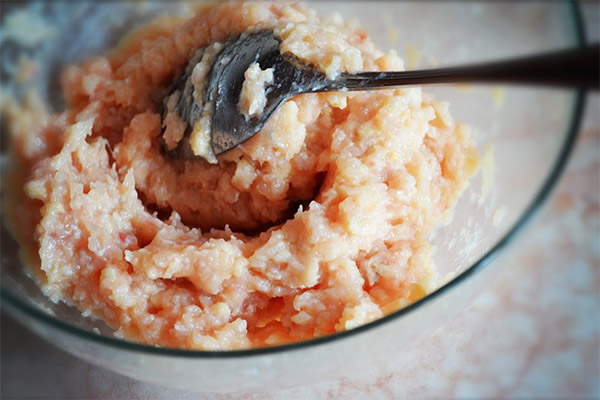
- Remove the skin from the sirloin parts. Wash the meat.
- Then spread the fillet on a cutting board, make an incision on the edge of the bones.
- Use a knife to remove bones.
- Then turn the fillet on the other side and also make a cut on both sides.
- Then carefully separate the resulting strip of flesh together with the bones.
- Remove small bones with tweezers. Peel the meat and mince it.
Can fish with scales be cooked?
Often, lovers of fish delicacies ask the question as to whether you can cook fish directly in the scales. Indeed, some varieties of fish products are cooked in this way. It is known that fish scales contain a lot of useful microelements, which are preserved during heat treatment. In addition, during cooking in the scaled fish is very juicy and tasty. Clean the fish carcass cooked in this way before serving. Usually this option is used for baking in the oven. From small river fish with scales prepared ukha. For example, in hot-smoking the scales should be left, so that the fish does not lose its nutritional juices during cooking.
Note: we must remember that this option is not always acceptable. So most fishermen still prefer to clean the catch before cooking from it even the simplest dishes.
It is not difficult to remember the subtleties of processing listed here, but these little secrets will help every hostess to successfully cope with the routine procedure of cutting fish.
«Important: All information on this site is provided for informational purposes only. for informational purposes only. Please consult with your health care professional before using any of the recommendations. specialist before using any of the recommendations. Neither the editors nor the authors shall be liable for any possible harm caused by materials."


